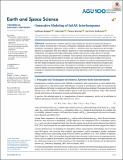Generative Modeling of InSAR Interferograms
Author(s)
Rongier, Guillaume; Rude, Cody; Herring, Thomas A.; Pankratius, Victor
DownloadPublished version (15.41Mb)
Publisher with Creative Commons License
Publisher with Creative Commons License
Creative Commons Attribution
Terms of use
Metadata
Show full item recordAbstract
Interferometric synthetic aperture radar (InSAR) has become an essential technique to detect surface variations due to volcanoes, earthquakes, landslides, glaciers, and aquifers. However, Earth's ionosphere, atmosphere, vegetation, surface runoff, etc., introduce noise that requires post-processing to separate its components. This work defines a generator to create interferograms that include each of those components. Our approach leverages deformation models with real data, either directly or through machine learning using geostatistical methods. These methods result from previous developments to more efficiently and better simulate spatial variables and could replace some statistical approaches used in InSAR processing. We illustrate the use of the generator to simulate an artificial interferogram based on the 2015 Illapel earthquake and discuss the improved performance offered by geostatistical approaches compared with classical statistical ones. The generator establishes a tool for multiple applications (1) to evaluate InSAR correction workflows in controlled scenarios with known ground truth; (2) to develop training sets and generative methods for machine learning algorithms; and (3) to educate on InSAR and its principles. ©2019
Date issued
2019-11Department
Massachusetts Institute of Technology. Department of Earth, Atmospheric, and Planetary Sciences; MIT Kavli Institute for Astrophysics and Space ResearchJournal
Earth and Space Science
Publisher
American Geophysical Union (AGU)
Citation
Rongier, Guillaume, Cody Rude, Thomas Herring, and Victor Pankratius, "Generative Modeling of InSAR Interferograms." Earth and Space Science 6, 12 (November 2019): p. 2671-83 doi 10.1029/2018EA000533 ©2019 Author(s)
Version: Final published version
ISSN
2333-5084